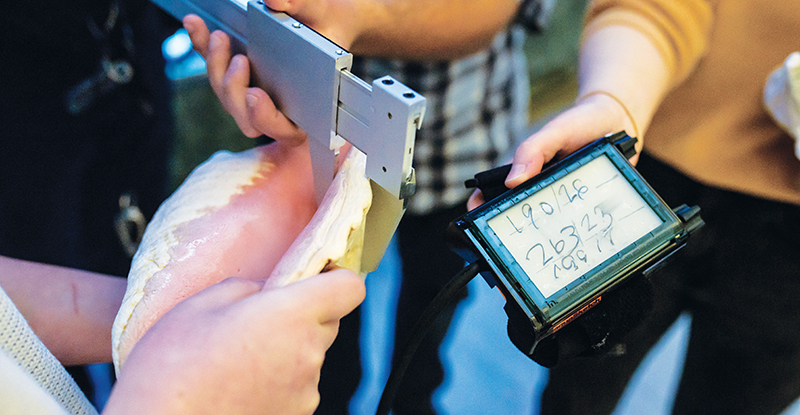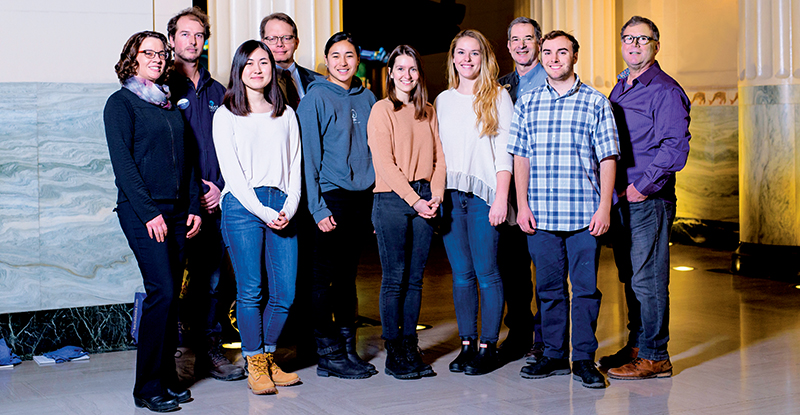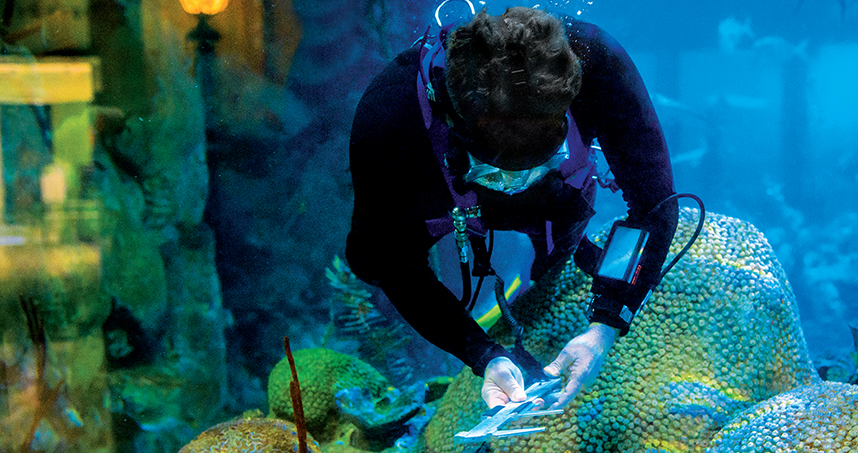Deep Dive
Northwestern Engineering students continue to delight Shedd Aquarium scientists year after year with innovative, collaborative solutions to important challenges.
“I’m really excited just to see the prototype in action. Seeing it being used like this under water by a diver is really amazing.”
On a quintessential winter day in Chicago, as the temperature barely approached zero, a group of Northwestern Engineering undergraduates remained firmly focused on the Bahamas.
With the frigid waters of Lake Michigan lapping on the edge of the city’s Museum Campus, five students in the Design 384: Interdisciplinary Design Projects course stayed warm inside the stately neoclassical Shedd Aquarium's octagonal vestibule, eyes locked on the Caribbean Reef exhibit.
Just minutes before, they’d had the chance to go behind the scenes of Shedd’s well-known exhibits celebrating aquatic life to prep the aquarium’s volunteer diver on how to test a prototype caliper they had designed to help scientists measure queen conch shells in the Bahamas.
Work on the prototype started in the classroom at the Segal Design Institute as part of a unique collaboration between Shedd and the McCormick School of Engineering that spans nearly 14 years. This team of Northwestern students comprises one of five Design 384 groups collaborating with Shedd this academic year — more groups than ever before.
The project is all the more important because conch populations are threatened. “We’re at a critical tipping point right now for the Bahamian conch,” says Shedd research biologist Andy Kough, who uses numerical modeling and dive surveys to explore conch populations. “The species has been widely fished for many, many moons, and most populations are in decline. They’re approaching a state of serial depletion, which means that regulations are needed in order to stop them from disappearing.”
Into the Reef
As the hands of Shedd’s brass clock — its face emblazoned with fish instead of numbers — indicated 2 p.m., Rich Fluck, the diver, entered the 90,000-gallon Caribbean Reef habitat specifically stocked with conch shells for him measure.
“I’m really excited just to see the prototype in action,” said Katherine McIlree, a senior in the McCormick Integrated Engineering Studies program as she watched Fluck. “Seeing it being used like this under water by a diver is really amazing.”
The collaborative project aims to help scientists like Kough learn more about the ages and sizes of conchs in certain populations in the Bahamas. The tools currently available to him and the citizen scientists he recruits to measure thousands of shells annually are less than ideal.
“The idea was that the students could help create a new generation of calipers that solve some of the problems we’ve encountered — which include everything from curious barracudas that are attracted to the shiny metal in our hands to degradation of the tools in the saltwater environment,” Kough says.
It’s exactly the type of assignment Segal students have tackled over the years, which have yielded practical solutions used regularly by Shedd staff. For instance, Northwestern students designed a fish anesthesia machine that continues to evolve more than a decade after its creation.
“We want the students to understand the process for doing design work,” says Stacy Benjamin, lead instructor for Design 384 and director of the Segal Design Certificate, a set of courses and projects that build design knowledge and skills. “As much as we want to produce a useful end deliverable, the real goal for students is to learn the process of problem solving. They’re learning how to explore, how to consider a wide range of stakeholder viewpoints and challenges, and to think critically about their own work.”

Long-time Partners
The collaboration began in 2005 when Bill Van Bonn, Shedd’s vice president for animal health, met McCormick Advisory Council member Bob Shaw (’70, MM ’81) and told him about the challenges aquariums face. This included the lack of a commercial market to supply equipment for aquarium-specific veterinary practice or enrichment activities for marine mammals, which meant solutions were in short supply.
Shaw suggested to Van Bonn that he approach Segal’s Benjamin about forming a client relationship with the design institute through which students could develop potential solutions for industry problems. In addition to participants from Design 384, students in the first-year course, Design 106: Design Thinking and Communication, also work on Shedd projects.
The results have been satisfying for both sides of the partnership. “It’s a wonderful opportunity for the students. They always get very excited about working with Shedd,” says John Anderson, co-director of the Segal Design Certificate and an instructor for Design 384. “There’s always a sense that we’re really doing something that is helping them out and will have an impact.”
Van Bonn agrees. “Some of us had been working on these issues for 10 years,” he says. “When we give these challenges to the students, a lot of times they come up with fantastic ideas that none of us have ever thought of.”

“As much as we want to produce a useful end deliverable, the real goal for students is to learn the process of problem solving. They’re learning how to explore, how to consider a wide range of stakeholder viewpoints and challenges, and to think critically about their own work.”
New Territory
The first collaborative projects revolved around needs for the aquarium’s on-site animal hospital. Over the years, however, interest has grown, and collaborations now include working with the animal care teams on husbandry and with Shedd’s Daniel P. Haerther Center for Conservation and Research.
“The students get very engaged because it’s not a traditional engineering project. They’re engineering problems but in a really cool context,” says Dan Brown, an instructor for the Design 384 class and director of the Ford Prototyping Lab, who is co-leading the conch group.
Another one of this year’s projects challenges students to create a “smart” penguin egg embedded with sensors to collect information about how penguins care for their eggs. With penguins facing declining populations, a fake egg that could collect information, such as temperature, humidity, movement, and rotation, could help animal care staff learn more about penguins’ breeding habits.
“We’re trying to figure out what we can do to help our animals breed more successfully and what can we do to help their counterparts in their natural environment do the same,” says Nikki Mason, senior trainer for marine mammals at Shedd.
“Testing should always be done in the most realistic conditions possible. With Andy’s help as our organizer and liaison, we were able to get the closest thing to the Bahamas that Chicago has to offer.”
The students’ work, which helps them acquire professional skills, could also contribute significantly to protecting wild populations by using the smart egg with many other species of birds.
“Working this closely with Shedd has reaffirmed that working in the product development sphere is what I’d love to do going forward,” McIlree says. “It has definitely shaped my view on how comfortable I feel with my communication and design skills.”
And, Shedd staff benefits from products that make their jobs easier. A puzzle maze created in 2013 serves as an enrichment tool for sea otters as they retrieve food trapped in a ball by navigating through an adjustable maze.
Sharks on the Move
Another team of students in Design 384 is helping animal care staff and veterinarians who care for sharks. When sharks need medical attention, they are moved to a smaller habitat to allow animal care staff and vets better access. Students are working to create a solution to help give staff more comfortable access to the sharks.
Observing sharks behind the scenes at Shedd provided Vivien Ng, a senior studying manufacturing and design engineering, a new learning experience. As Ng stood near a giant exhibit where sharks swam around, she watched Shedd staff working together restocking a refrigerator with labeled plastic bins containing food for the sharks.
“I’m from Chicago, and when we were little, we’d go on field trips to Shedd,” Ng says. “I remember really liking the dolphins and penguins, but I never really understood how Shedd scientists cared for the sharks. I now have a lot more respect for that work.”
Meanwhile, Back at the Reef
After Fluck surfaced from his dive to try out the new caliper prototype, the student team met behind the scenes with Fluck, another diver, and Kough to debrief. The students learned the prototype could be streamlined for diver comfort while reducing the risk of damaging the reef.
“The feedback they gave us was all actionable. That was really awesome because it included things we knew we could check off our list immediately and continue going forward in that design direction,” McIlree says.
For instance, O-rings attached to the shoulder straps of the dive gear could allow the diver to carry the tool handsfree, making it easier to swim to the conch. “That really surprised us. We hadn’t thought of that,” McIlree adds. “But once we saw the caliper in the water and how it would react with objects around it, it became incredibly apparent what was needed.”
The team also learned that duller tools would prevent accidental cuts for the diver or the conch. “Every extra piece of equipment introduces a variable that increases the risk of damaging the reef,” says Lauren Burns, a senior studying manufacturing and design engineering. “Our team was able to learn so much more seeing our devices in action.”
The students met with Kough throughout the quarter to refine the prototype. The team made several calipers, which could be used for years — or perhaps decades — to come, for Kough to use on upcoming research trips to the Bahamas.
“Testing should always be done in the most realistic conditions possible,” Burns says. “With Andy’s help as our organizer and liaison, we were able to get the closest thing to the Bahamas that Chicago has to offer.”
The collaboration might grow to involve projects beyond the aquarium walls — including animal rescue and rehab and endangered species protection. “For us, it’s a small investment in attention to the students. But the return is really incredible,” Van Bonn says. “They create physical prototypes for us, and we get the satisfaction of contributing to these students’ education and getting them excited about our world.
"When you combine the resources that McCormick brings with those that Shedd makes available to the students,” he adds, “it’s pretty cool.”

